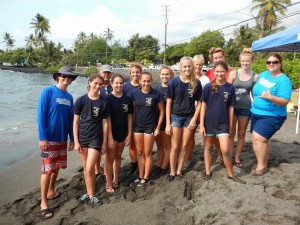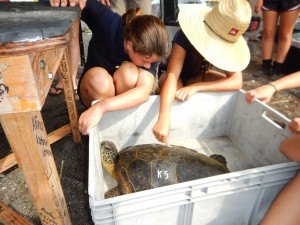 In October of 2014 Kahalu‘u Bay Education Center launched Hurdles for Turtles, a program to monitor honu (green sea turtles) in Kahalu‘u Bay. By learning how, when, and where honu are using Kahalu‘u Bay, we can be more effective and efficient with our outreach and protection activities.
In October of 2014 Kahalu‘u Bay Education Center launched Hurdles for Turtles, a program to monitor honu (green sea turtles) in Kahalu‘u Bay. By learning how, when, and where honu are using Kahalu‘u Bay, we can be more effective and efficient with our outreach and protection activities.
Kahalu‘u Bay is a unique place where honu consistently forage for food and rest on the beach. People and turtles interact at Kahalu‘u Bay on a daily basis. Most of the time these interactions are positive, with people observing turtles without disturbing or scaring them. But occasionally these interactions are not positive, such as when baygoers chase, get too close, or even touch or pick up honu, making them feel boxed in or threatened. Kahalu‘u Bay has a dense population of turtles and competition for food and territory can be high; when baygoers exhibit threatening behavior, turtles may begin to avoid Kahalu‘u. Our ReefTeach volunteers engage baygoers on the shoreline and in the water to help them understand the importance of respecting turtles and giving them space. This ensures that our honu feel safe at Kahalu‘u and continue to inhabit the bay, so that residents and visitors alike can continue to enjoy seeing these docile and elegant creatures in their natural habitat.
Through Hurdles for Turtles, teams of trained volunteers, students, and teachers go out in search of honu and carefully inspect, measure, weigh, number, and tag them with microchips before releasing them back into the bay. In the program’s first month, 29 turtles were identified; since then their movements and locations have been recorded as well as the number of interactions with people and at what distances. Collected data allow us to better understand when and where sea turtles are encountered, so that ReefTeachers will be better prepared to educate visitors on how and where to observe them safely and respectfully.
View our Sea Turtle Identification Guide
 In March 2015 we were given the opportunity to attach satellite tags to two of our turtles, K1 and K3. For six hours each day, the turtles transmit their locations to us so that we can learn what areas are important to protect. When honu leave Kahalu‘u Bay we generally don’t know where they go. Satellite data help us better understand the turtles’ movements so we can be more effective in protecting those areas.
In March 2015 we were given the opportunity to attach satellite tags to two of our turtles, K1 and K3. For six hours each day, the turtles transmit their locations to us so that we can learn what areas are important to protect. When honu leave Kahalu‘u Bay we generally don’t know where they go. Satellite data help us better understand the turtles’ movements so we can be more effective in protecting those areas.
All of the marks and satellite tags are temporary and will eventually fall or rub off. The microchips, however, are permanent, allowing us to determine if we’ve encountered a particular honu before. By comparing size and date information, we can learn how quickly these turtles grow and how old they are.
Check out some of the data we’ve collected and a website produced by Dr. Marc Rice and Hawai‘i Preparatory Academy specifically for this project.
Hurdles for Turtles is managed by Kahalu‘u Bay Education Center and funded through a grant from the National Oceanic and Atmospheric Administration (NOAA). The program is conducted in cooperation with Dr. Marc Rice, Laura Jim, and students from Hawai‘i Preparatory Academy; and Marie Chavis, Amalea Saunders, and students from West Hawai‘i Explorations Academy. Many hours of work from staff and volunteers of Kahalu‘u Bay Education Center contribute to the success of this program.

